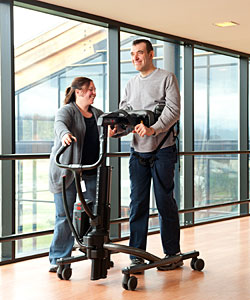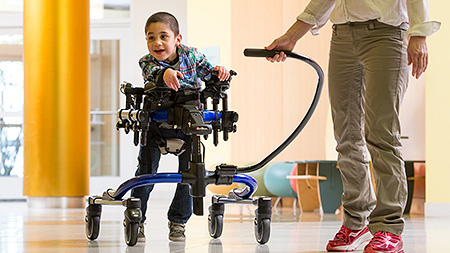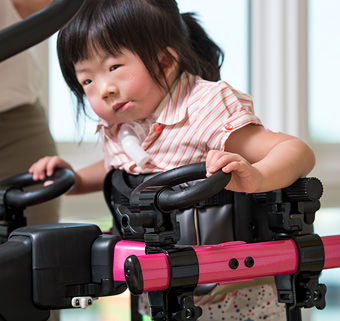The Rifton TRAM or the Rifton Pacer
Which Should I Use for Gait Training?
| October 2012
Since our newest item, the Rifton TRAM, has a walking component with similar prompts to the Pacer such as arm prompts, chest support, and walking saddle, therapists often wonder which to choose if they’re primarily interested in ambulation or gait training.

Because the TRAM does a lot more than gait training – it’s a three-in-one device that combines sit-to-sit transfer, sit-to-stand lift, and ambulation – it tends to be a first choice especially for individuals who are heavy and difficult to transfer onto a toilet or into an upright position. But for pure gait training the Pacer offers more prompts and more functionality. It all comes down to the particular needs and abilities of the client.
The more involved the user, the more support needed for gait practice. Some prompts are found on both the TRAM and the Pacer, such as the arm prompts and the pelvic positioner (called a walking saddle on the TRAM). But other prompts have differences, like the trunk support. Below is a list of features to consider when choosing your device.
So ultimately, your choice comes down to the particular needs of your client. Familiarity with all the functions of both devices is key. Then let your own assessment be your guide.
| TRAM Body Support Body support height can be effortlessly adjusted and finely tuned with the client in the device. Body support is rigid providing postural support. |
PACER Trunk Support Trunk support is height-adjustable, but must be positioned before client is in device. Trunk support is flexible allowing for anterior and posterior tilt adjustments for users with extensor or flexion trunk patterns during gait. |
| TRAM Footprint Footprint is compact for greater maneuverability in confined spaces such as the home or bathrooms. |
PACER Footprint Large footprint to provide maximum stability and stride length during gait. |
| TRAM Lower Extremity Control No options at present to provide for lower extremity control. |
PACER Thigh and Ankle Prompts The Pacer has thigh and ankle prompts to control adducted (scissor) gait, foot placement, and stride length. |
| TRAM Weight-Bearing Components Walking saddle provides weight-bearing support during gait and standing. TRAM has a scale that can be used to measure client’s weight-bearing abilities (off-weighting). |
PACER Weigh-Bearing Components Flexible pelvic positioner provides weight-bearing support during gait and standing. Rigid hip positioner provides weight-bearing support as well as pelvic control during gait.No scale with Pacer. |
| TRAM Wheels Full wheel locks and optional swivel locks. |
PACER Wheels Full wheel locks, directional locks, a drag, and swivel locks. |




